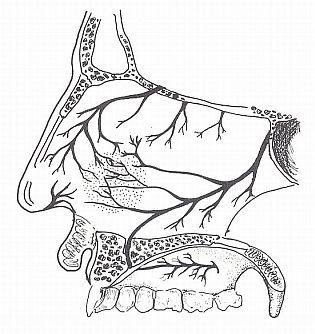 Hemorragia de origen nasal, por causas que actúan localmente sobre las estructuras nasosinusales o por padecimientos sistémicos en los que la epistaxis resulta una manifestación más. Siempre hay una lesión epitelio nasal, herida, erosión o necrosis, para que ocurra el sangrado.
Hemorragia de origen nasal, por causas que actúan localmente sobre las estructuras nasosinusales o por padecimientos sistémicos en los que la epistaxis resulta una manifestación más. Siempre hay una lesión epitelio nasal, herida, erosión o necrosis, para que ocurra el sangrado. <(A): Epistaxis, Nasenbluten: Die Nase ist ein sehr gefässreicher Teil des Körpers, der sich in einer verletzlichen Position im Gesicht befindet. Infolgedessen kann jedes Trauma im Gesicht zu Blutungen führen, die sehr stark ausfallen können. Nasenbluten kann spontan auftreten, wenn die Nasenschleimhäute austrocknen, verkrusten und reißen, wie es in trockenen Klimazonen üblich ist, oder während der Wintermonate, wenn die Luft trocken und warm von Haushaltsheizungen ist. Weitere prädisponierende Faktoren sind Infektionen, Traumata, allergische und nicht allergische Rhinitis, Bluthochdruck, Alkoholmissbrauch und erbliche Blutungsprobleme.
<(F): Épistaxis: est un symptôme et non une maladie; saignement issu de la fosse nasale, motif de consultation fréquent en ORL; généralement bon pronostic. moins de 10% des épistaxis sont dues à une maladie néoplasique ou une coagulopathie.
<(Ing): Epistaxis, nosebleed: the nose is a part of the body that is very rich in blood vessels and is situated in a vulnerable position on the face. As a result, any trauma to the face can cause bleeding which may be profuse. Nosebleeds can occur spontaneously when the nasal membranes dry out, crust, and crack, as is common in dry climates, or during the winter months when the air is dry and warm from household heaters. Other predisposing factors include infection, trauma, allergic and non-allergic rhinitis, hypertension, alcohol abuse, and inherited bleeding problems.
BASES DE DATOS DE INFORMACIÓN BIOMÉDICA:
- CISMeF. <(F)
-
EMEDICINE. <(Ing)
- PubMed. <(Ing)
-
Scientific Electronic Library Online. <(E) - <(P) - <(Ing)
CASOS CLINICOS:
-
EPISTAXIS. <(Ing)
INFORMACIÓN PACIENTES:
- CENTRO MEDICO IMBANACO. <(E)
- ECUREME. <(Ing)
PEDIATRIA:
-
EMEDICINE. <(Ing)
RECURSOS:
-
@HEADandNECK.COM. <(Ing)
TEXTOS:
-
EMEDICINE. <(Ing)
-
MANUAL MERCK. <(Ing)
TÉRMINOS RELACIONADOS:
